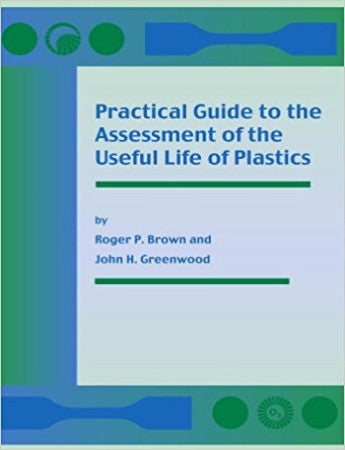Practical Guide to the Assessment of the Useful Life of Plastics
After price and delivery time, the most frequently asked question about a product is 'How long will it last?' Lifetime expectancy is often many years, the service conditions may be complex, and there is a scarcity of definitive data on durability. The situation is complicated by the fact that there are a vast number of degradation agents, service conditions, properties of importance and different plastics.
There are many inherent difficulties in designing durability tests. In many cases, the time scale involved is such that accelerated test conditions are essential. Whilst large amounts of durability data are generated by accelerated methods, much of it is only useful for quality control purposes and relatively little has been validated as being realistically capable of representing service.
Most assessments of the lifetime of plastics are made by considering some measure of performance, such as impact strength, and specifying some lower limit for the property, which is taken as the endpoint. Lifetime is not necessarily measured in time. For example, for some products, it will be thought of as the number of cycles of use.
The object of this publication is to provide practical guidance on assessing the useful service life of plastics. It describes test procedures and extrapolation techniques together with the inherent limitations and problems. The Guide aims to make available the wealth of information that can be applied to help maximise the effectiveness of a durability-testing programme.
This guide seeks to be comprehensive but concentrates on the most common environmental effects causing degradation. The test procedures used are outlined and the relevant textbooks and international standards are well referenced. Examples of lifetime testing studies are cited.
This book will be useful for anyone responsible for designing, manufacturing or testing plastic components. It will also be of benefit to suppliers and users of end products, as an assessment of useful lifetime is critical to the economics and safety aspects of any component.
There are many inherent difficulties in designing durability tests. In many cases, the time scale involved is such that accelerated test conditions are essential. Whilst large amounts of durability data are generated by accelerated methods, much of it is only useful for quality control purposes and relatively little has been validated as being realistically capable of representing service.
Most assessments of the lifetime of plastics are made by considering some measure of performance, such as impact strength, and specifying some lower limit for the property, which is taken as the endpoint. Lifetime is not necessarily measured in time. For example, for some products, it will be thought of as the number of cycles of use.
The object of this publication is to provide practical guidance on assessing the useful service life of plastics. It describes test procedures and extrapolation techniques together with the inherent limitations and problems. The Guide aims to make available the wealth of information that can be applied to help maximise the effectiveness of a durability-testing programme.
This guide seeks to be comprehensive but concentrates on the most common environmental effects causing degradation. The test procedures used are outlined and the relevant textbooks and international standards are well referenced. Examples of lifetime testing studies are cited.
This book will be useful for anyone responsible for designing, manufacturing or testing plastic components. It will also be of benefit to suppliers and users of end products, as an assessment of useful lifetime is critical to the economics and safety aspects of any component.
1. Introduction
2. Definition of the Polymer
3. What is Failure?
4. Agents and Mechanisms of Degradation
5. Real and Simulated Service Conditions
6. Accelerated Tests
7. Parameters to Monitor Degradation
8. Prediction Techniques
9. Limitations, Pitfalls, and Uncertainties
10. Condition Monitoring and Residual Life Assessment
11. Data Available
12. Examples of Current Practice
13. Conclusion
Abbreviations and Acronyms
Index
2. Definition of the Polymer
3. What is Failure?
4. Agents and Mechanisms of Degradation
5. Real and Simulated Service Conditions
6. Accelerated Tests
7. Parameters to Monitor Degradation
8. Prediction Techniques
9. Limitations, Pitfalls, and Uncertainties
10. Condition Monitoring and Residual Life Assessment
11. Data Available
12. Examples of Current Practice
13. Conclusion
Abbreviations and Acronyms
Index
Roger Brown is an internationally acknowledged expert on physical testing and quality assurance of polymers. He has published more than 70 technical papers and three standard textbooks on testing. In addition, he is editor of the journal Polymer Testing and co-editor of the newsletter The Test Report. He has over 25 years experience of running the testing laboratories and services at Rapra. Roger is active on many Standards committees.
Dr. John Greenwood studied at Cambridge and has worked for over thirty years on non-metallic materials for companies in America and Europe. He is an authority on mechanical testing and lifetime prediction of polymer and composite materials including pipes and geosynthetics. He has published extensively, including patents, and is the convenor of working groups for the
standardisation of geotextiles and fuel pipes. He is currently non-metals
consultant at ERA.
Dr. John Greenwood studied at Cambridge and has worked for over thirty years on non-metallic materials for companies in America and Europe. He is an authority on mechanical testing and lifetime prediction of polymer and composite materials including pipes and geosynthetics. He has published extensively, including patents, and is the convenor of working groups for the
standardisation of geotextiles and fuel pipes. He is currently non-metals
consultant at ERA.




